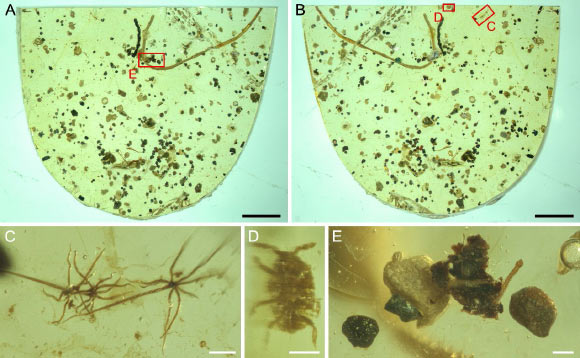Paleontologists from the Nanjing Institute of Geology and Palaeontology at the Chinese Academy of Sciences and elsewhere have found a partial body fossil of an ancient tapeworm preserved in mid-Cretaceous Kachin amber from Myanmar.
The 99-million-year-old amber piece containing the fossil tapeworm (long tentacle) and other inclusions: (A-B) the overall view of the amber piece; (C) gleicheniacean trichomes; (D) scale insect nymph; (E) sand grains. Scale bars – 2 mm in (A,B), 0.1 mm in (C-E). Image credit: Luo et al., doi: 10.1130/G52071.1.
Parasites are ubiquitous in extant ecosystems but rarely preserved in the geological record, especially parasitic worms.
One such group is Cestoda (tapeworms), a specialized endoparasitic group of flatworms.
These creatures have a complex lifecycle with at least two hosts, infecting all major groups of vertebrates.
However, their fossil record is extremely sparse due to their soft tissue and concealed habitats, with the only widely accepted example before the Quaternary being eggs discovered in a shark coprolite from the Permian period.
The lack of body fossils greatly hampers our understanding of their early evolution.
“The fossil record of tapeworms is extremely sparse due to their soft tissues and endoparasitic habitats, which greatly hampers our understanding of their early evolution,” said Dr. Bo Wang, a researcher with the Nanjing Institute of Geology and Palaeontology at the Chinese Academy of Sciences.
The new fossil displays unique external (armature pattern) and internal (partially invaginated tentacle and rootless hooks) features that are most consistent with the tentacles of extant trypanorhynch tapeworms that parasitize marine elasmobranchs (mainly sharks and rays).
“The find is the most convincing body fossil of a platyhelminth ever found,” said Cihang Luo, a Ph.D. candidate with the Nanjing Institute of Geology and Palaeontology at the Chinese Academy of Sciences.
“Our study, which provides an exceptional example of a marine endoparasite trapped in amber, has also shed new light on the taphonomy of amber.”
“Specifically, we showed that amber can preserve the internal structure of helminths.”
“Using high-resolution micro-CT, we discovered that the interior of the current fossil has a folded longitudinal structure that appears to run in a spiral around the longitudinal axis and extends to the anteriormost part. This is consistent with the invaginated tentacle of a trypanorhynch.”
“Meanwhile, the rootless hooks are also the same as those of trypanorhynchs.”
“Previous studies had shown that internal structures could be preserved intact as in extant forms, but such studies all focused on arthropods.”

A hypothetical ecological reconstruction of the fossil trypanorhynch tapeworm. Image credit: Dinghua Yang / Luo et al., doi: 10.1130/G52071.1.
“Our results show that amber can preserve the internal structure of helminths such as tapeworms on geologic time scales,” Dr. Wang said.
“Along with the remarkable example of a marine endoparasite trapped in amber, some gleicheniacean trichomes and a scale insect nymph were also preserved with the partial worm fossil in the same amber specimen.”
“This clearly indicates a terrestrial or onshore environment at the time of entrapment in resin.”
“In addition, many sand grains were evenly distributed throughout the amber, suggesting that the fossil was entombed in a sandy environment.”
“Furthermore, previous evidence shows that the Kachin amber was deposited in a near-shore environment.”
“One possible scenario for the deposition of the tapeworm in the amber is that its elasmobranch host was stranded by a tide or storm.”
“Under such a scenario, the host was then bitten by a higher-level terrestrial predator or scavenger.”
“When the host was ingested by the predator, the tentacle was pulled away, dislodged from the intestine, and stuck to nearby resin.”
“Our study further supports the hypothesis that the Kachin amber was probably deposited in a paralic paleoenvironment, and also highlights the importance of amber research in paleoparasitology.”
The team’s paper was published in the journal Geology.
_____
Cihang Luo et al. Exceptional preservation of a marine tapeworm tentacle in Cretaceous amber. Geology, published online March 22, 2024; doi: 10.1130/G52071.1


